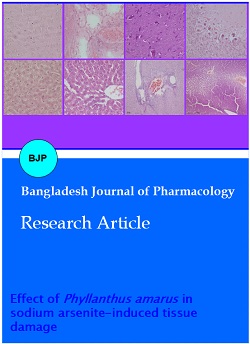Effect of Phyllanthus amarus in sodium arsenite-induced tissue damage
DOI:
https://doi.org/10.3329/bjp.v17i3.59819Keywords:
Arsenic, Medicinal plant, Phyllanthus amarus, RatAbstract
This study aims to evaluate the effect of alcoholic extract of Phyllanthus amarus leaves on arsenic-induced histological changes in Wistar rats. Rats were divided into 4 groups: Group I: normal control; Group II: rats received sodium arsenite (40 mg/kg); Group III: rats received sodium arsenite (40 mg/kg) + P. amarus extract (100 mg/kg); Group IV: rats received sodium arsenite (40 mg/kg) + extract (200 mg/kg). All groups were treated by oral gavage with sodium arsenite for 28 days and the animals were subsequently administered (oral) with 100 and 200 mg/kg extract, once daily for two weeks. Animals were sacrificed 24 hours after the last treatment and different organs were collected for histopathological analysis. Results revealed mild to severe type of necrosis and degenerative changes in brain, kidney, and liver of arsenic fed animals. In rats administered with extract showed significant improvements, and the normal histological feature of the cells was almost restored in rats. These suggest that P. amarus can be used to treat arsenic-induced multi-organ damages.
Downloads
174
146
References
Adeneye AA, Benebo AS. Protective effect of the aqueous leaf and seed extract of Phyllanthus amarus on gentamicin and acetaminophen-induced nephrotoxic rats. J Ethnopharmacol. 2008; 118: 318-23.
Arasan E, Vijayalakshmi M, Devalarao G. Anthelmintic screening of various crude extracts of Phyllanthus simplex Retz. Res J Pharm Biol Chem Sci. 2010; 1: 425-28.
Bancroft JD, Gamble M. Theory and practice of histopathological techniques. 8th ed. Philadelphia, Churchill Livingstone Elsevier, 2019, p 55.
Centeno JA, Mullick FG, Martinez L, Norbert P, Gibb H, Longfellow D. Pathology related to chronic arsenic exposure. Environ Health Perspect. 2002; 110 (Suppl 5): 883-86.
Duzguner V, Kaya S. Effect of zinc on the lipid peroxidation and the antioxidant defense systems of the alloxan-induced diabetic rabbits. Free Radical Biol Med. 2007; 42: 1481-86.
Devi S, Rashid R, Kumar M. Phytochemistry and pharmacological properties of Phyllanthus amarus Schum: A review. Pharma Innov J. 2017; 6: 169-72.
Divya K, Ankur R, Seema Ro, Khan MU. Pleiotropic multifaceted therapeutic potential of Phyllanthus amarus. Int J Pharm Biol Arch. 2011; 2: 610-14.
Flora SJS, Mehta A, Mital M. Heavy metal-induced oxidative stress and its possible reversal by chelation therapy. Ind J Med Res. 2008; 128: 221-24.
Flora SJS. Arsenic-induced oxidative stress and its reversibility. Free Rad Biol Med. 2011; 51: 257-81.
Ferzand R, Gadahi JA, Saleha S, Ali Q. Histological and haematological disturbance caused by arsenic toxicity in mice model. Pakistan J Biol Sci. 2008; 11: 1405-13.
Gaim K, Gebru G, Abba S. The effect of arsenic on liver tissue of experimental animals (fishes and mice): A review article. Int J Sci Res Publ. 2015; 5: 1-9.
Hashim A, Manikoth S, Pai VR. Role of medicinal herbs in the treatment of arsenic-induced toxicity. Int J Med Toxicol Legal Med. 2019; 22: 29-33.
Jolliffe D. A history of the use of arsenicals in man. J Royal Soc Med. 1993; 86: 287.
Kasote DM, Katyare SS, Hegde MV, Bae H. Significance of antioxidant potential of plants and its relevance to therapeutic applications. Int J Biol Sci. 2015; 11: 982.
Karuna R, Reddy SS, Baskar R, Saralakumari D. Antioxidant potential of aqueous extract of Phyllanthus amarus in rats. Indian J Pharmacol. 2009; 41: 64-67.
Lee NY, Khoo WK, Adnan MA, Mahalingam TP, Fernandez AR, Jeevaratnam K. The pharmacological potential of Phyllanthus niruri. J Pharm Pharmacol. 2016; 68: 953-69.
Mabuchi K, Lilienfeld AM, Snell LM. Cancer and occupational exposure to arsenic: A study of pesticide workers. Prev Med. 1980; 9: 51-77.
Mao X, Wu LF, Guo HL, Chen WJ, Cui YP, Qi Q, Li S, Liang WY, Yang GH, Shao YY, Zhu D. The genus Phyllanthus: An ethnopharmacological, phytochemical, and pharmaco-logical review. Evid Based Complement Alternat Med. 2016; 2016.
Nikam PS, Nikam SV, Sontakke AV, Khanwelkar CC. Role of Phyllanthus amarus treatment in hepatitis-C. Biomed Res. 2011; 22: 319-22.
Patel JR, Tripathi P, Sharma V, Chauhan NS, Dixit VK. Phyllanthus amarus: Ethnomedicinal uses, phytochemistry, and pharmacology. J Ethnopharmacol. 2011; 138: 286-313.
Roy S, Bhattacharya S. Arsenic-induced histopathology and synthesis of stress proteins in liver and kidney of Channa punctatus. Ecotoxicol Environ Saf. 2006; 65: 218-29.
Udupa AL, Sanjeeva, Benegal A, Prusty V, Prabhath G, Kodancha P, et al. Diuretic activity of Phyllanthus niruri (Linn) in rats. J Health. 2010; 2: 511-12.

Downloads
Published
How to Cite
Issue
Section
License
Copyright (c) 2022 Hashim Achummantakath, Prasanna KS, Nizamudeen AS

This work is licensed under a Creative Commons Attribution 4.0 International License.
Authors who publish with this journal agree to the following terms:
- Authors retain copyright and grant the journal right of first publication with the work simultaneously licensed under a Creative Commons Attribution License that allows others to share the work with an acknowledgement of the work's authorship and initial publication in this journal.
- Authors are able to enter into separate, additional contractual arrangements for the non-exclusive distribution of the journal's published version of the work (e.g., post it to an institutional repository or publish it in a book), with an acknowledgement of its initial publication in this journal.
- Authors are permitted and encouraged to post their work online (e.g., in institutional repositories or on their website) prior to and during the submission process, as it can lead to productive exchanges, as well as earlier and greater citation of published work (See The Effect of Open Access).
